Indigeneity and Identity
An Interview with Dakota Camacho
BY EMMALY WIEDERHOLT
Dakota Camacho is a multi-disciplinary artist from Låguas yan Gåni, the ancestral homeland of Matao/CHamoru people (Dominating culture calls this archipelago the Mariånas Islands). Dakota works in spaces of Indigenous performance, musical composition, community engagement, and education. Guiya (they) is also a co-founder of I Moving Lab, an Indigenous, international, intercultural and interdisciplinary arts collective. Here, Dakota shares yo-ña (their) thoughts on Indigeneity as a worldview, especially in the contexts of performance and community.
MALI’E | higher.infinite.power.healing.our.people performed at On The Boards December 2018, Photo by Naomi Ishisaka
~~
Can you tell me a little about your dance history – what kinds of performance practices and in what contexts have shaped who you are today?
I started moving in the womb with my twin sister, Austin. My first dances were with her. When I was three years old, my family started the Håfa Adai Cultural Dance Troupe. My ancestral lineage on my dad’s side (Matao/CHamoru) stopped practicing our traditional dances about 300 years ago as we made tough decisions about how to survive colonizing and attempted genocide. The dance troupe my family started was informed by the touristy kind of Pacific Island Dance, similar to what you might find at the Polynesian Cultural Center. In our performances, we represented Guåhan and the Pacific Islands. The Pacific Island cultural dances were traditional dances we learned, while our CHamoru cultural dances were hula movements choreographed by my Aunties and my Nåna to CHamoru pop music.
I also did dance battles in middle school. Around that time, I learned about colonization. I started reading about my culture and realized that my culture had been disrupted. I’d always heard the standard European perspective about Indigenous culture, that it is dying/dead/lost/threatened. Through the process of learning about my culture, I learned about this tradition called Mali’e. It’s our form of oral history, done in the collective, kind of like a rap battle. Someone sings four rhyming lines, and then another person sings four lines back at them. The rhymes can be flirty, recite history, or boast poetic skill. I didn’t have access to learning my language at the time. My grandparents were passing away, and they knew the language but not how to teach it. I felt empowered by knowing about my ancestors’ poetic tradition and started to feel called to write poetry. I recognized that Mali’e was similar to rap music and, if I couldn’t write poetry in this ancestral form, I would at least be able to channel the spirit of my ancestors through rhyme, freestyle, and poetry.
My early childhood was difficult. I grew up in a deeply devoted Catholic family in a very patriotic navy town where none of my peers recognized my culture. I never saw my queer or Indigenous self reflected in the school curriculum or in pop culture. I often felt invisible and isolated.
The most important thing to me at that time was being and feeling seen and a part of a community. When I was 14, my older sister DeAnn took my twin and I to Folklife Festival where we ‘randomly’ ended up dropping into a performance by Abyssinian Creole, a legendary Seattle hip hop duo. Hearing Gabriel Teodros and Khingz lyrics changed my life. Their personal narratives spoke to my family’s experience as immigrants and the feminist and human values my sister was encouraging me to think about and embody. It was the first time I felt really seen and reflected. For the next year, my twin and I tried going to every one of their shows and started to become a part of the hip hop community in Seattle.
When my twin sister and I were 15, we moved to the south end of Seattle with my older sister DeAnn and her partner Amanda. I participated in my first poetry slam sharing some of my most private and terrifying secrets with a crowd of people who to my surprise loved my work.
I became a member of Youth Speaks Seattle and a student of hella dope Seattle hip hop artists and organizers through the Katalyst Project at WAPIFASA. I’m so grateful that I had role models who brought me into the hip hop community and art form and supported me in my healing from internalized genocide. I realize now that I have a spiritual-ethical responsibility to the ancestors of past-present-future of this Black cultural art form and this is a place my work is investigating right now.
MALI’E | higher.infinite.power.healing.our.people performed at On The Boards December 2018, Photo by Naomi Ishisaka
When I was still in high school, I received a hip hop scholarship to University of Wisconsin-Madison and made a hip hop theater piece. During the research for that, I went to Guåhan for the first time to learn about song and dance traditions. Right before leaving, a friend took me to a Danza Mexica ceremony, and it was mind-blowing. It was the first time I saw dance in a ritual context. I had so many questions. I felt connected but separate, seeing these people’s rich tradition. It brought to the surface the trauma of attempted genocide.
When I went to Guåhan, I found out that my cultural community took a similar path that my family took to reconstructing our dance practices. During the cultural revitalization, hula was the closest approximation of Pacific dance they knew. This is a gross analysis, and I’ve written a lot about this more sensitively, but the gist is that somebody named Frank Rabon learned hula and used that movement style to re-imagine CHamoru cultural dance. It’s very contentious. Not a lot has changed in the 30 years of their movement; they are still using Hawaiian movement and instruments and calling it CHamoru cultural dance. When I learned that history, I said, that’s definitely not my culture, and started looking for something that felt more real to me.
I got directed to this group called I Fanlalai’an Oral History Project. What drew me to them was that they were very critical about their approach to reconstructing the culture of Matao/CHamoru people. They greatly value fino’ håya — the Indigenous language. Contemporary CHamoru has heaps of loan words from Spanish, German, English and Japanese. ‘CHamoru’ itself isn’t an Indigenous name, it comes from Spanish. This group’s compositions are only in fino’ håya, which is different from other groups who use lots of Spanish and English loan words, like “Corazon” or “kurason” to talk about the heart. I was initiated as a member of I Fanlalai’an and learned their canon. I represented our culture at the Festival of Pacific Arts in 2012, and then went back to Turtle Island (USA) and completed my degree.
At the Festival of Pacific Arts, it was recommended to me by my chant teacher and a CHamoru dance scholar to see Atamira Dance Company perform – the Māori contemporary dance company Jack Gray co-founded in Aotearoa (New Zealand). It changed my life.
I next went to NYU to get my master’s in Performance Studies. My first couple semesters were awful. I was told multiple times that Indigenous Studies isn’t Performance Studies, even though Performance Studies is interdisciplinary by definition. After completing an exercise in Anna Deavere Smith’s class, she told me, “Why don’t you do your ceremony in a temple somewhere or back on your reservation?” I tried to engage with her about this comment, and I had to go through a whole negotiation process with Anna and the head of my department to help them figure out how they were going to support Indigenous students. I was functionally kicked out of the class and opted to do an independent research project. Jack Gray and I were good friends and he jumped on an airplane to come support me. We asked: “How do we bring the idea to New York that every piece of the earth is sacred?” That question turned into a weeklong performance research laboratory called Lenapehoking Transformance Laboratory. From there, I developed a solo performance called Guåhu Guåhan. I ended up performing at University of Wisconsin-Madison and at the Indigenous Choreographers at Riverside Gathering. Those were my beginnings in Indigenous Contemporary Dance.
Buried Beneath: Bombs & Latte performed at Linebreaks Hip Hop Theatre Festival 2013
How would you generally describe the myriad work you do to someone unfamiliar with it?
I don’t really know. I answer the question differently depending on how I’m feeling that day, what project I’m working on, or how much I feel like saying about myself. My contact card says I’m an interdisciplinary Indigenous artist. I’m interested in the art of bringing people together and how to create experiences where we can be in touch with our land, ancestors, spirits and each other. That takes many different forms – performances, workshops, installations, altars, ceremonies. I practice sound design also, looking at how to create a sound experience that connects people to earth sonically and unconsciously. I’m a hip hop artist and lyricist, which is another vehicle. I’m inherently interested in working in community. That also is my art form: How does a solo artist figure out how to be creative in community?
Can you share a bit about how I Moving Lab came into existence?
After the Lenapehoking Transformance Laboratory, Jack had another residency in New York, and I went with him because it came out of the research I had started at NYU. After that, we went to Guåhan and did the Matao New Performance Project. That project for me was about how to create Matao or CHamoru performance work. It was about how to create dance as CHamoru people in a moment when we don’t have a traditional form of dance with continuity that is recognized as being authentic. How does the body become a vessel for ancestors to come through?
In 2016, the Festival of Pacific Arts was in Guåhan. We wanted to use it as an opportunity to say: Hey Pacific, there’s this new dance movement happening. My contribution was figuring out how to create embodiment methods that give life to our worldview. After that project, we came back to Turtle Island, and that’s when I Moving Lab was born.
We were basically doing a bunch of different things with different people in different places. Jack and I were going all over – Illinois, Sweden, South Africa, Hawai’i, Australia – doing our work. The question became: How do we talk about it? First, we are moving, both through dance and through travel. We were going to call it Indigenous Moving Lab but it made our logo design too long. So we shortened it to I MOVING LAB and the I’s just kept unfolding… Indigenous, intercultural, international and interdisciplinary – four I’s. So I Moving Lab became the umbrella for what we did. I played a bunch of roles – hip hop artist, sound design, graphic and web design, lyricist, cultural worker/negotiator, and doing embodiment work. We built cultural exchanges. Things just kept evolving and unfolding. In the Indigenous performing arts, there wasn’t an idea that work could be mobile in this way. We were travelling and working with local people – bringing our experiences and ideas and also asking how to be a part of the conversation in a way that supports and flourishes the local Indigenous concerns. We asked: What are the conversations Indigenous people are having and how can we use our bodies to be in service of that idea?
Indigenous Choreographers at Riverside 2015, Photo by Jonathan Godoy
Can you share about one or two projects that are maybe current or were particularly important to you?
I’ll talk about my performance research project MALI’E. That piece came about because of my interest in Mali’e: What is this ancestral form? What’s the potential of it today? How is an attempt to recreate the art form and access the creative potential an insight into our ancestral knowing? I realized it was important for me to develop a process to be specific about where my cultural framework is operating. In trying to understand my story and why it’s taken so many routes through different Indigenous territories and artforms, I’m trying to make sense of my own identity. I also wanted to be able to create knowledge specific to my culture.
“Mali’e” can mean “to have been seen” and is both a term to refer to a traditional poet and a particular practice of embodied, improvisatory, rhyming, collective singing. One form in particular is done by freestyling octo-syllabic rhyming couples. This form is also called ayotte’ or kantan chamorrita.
For the first performance of this research, I had just moved back to Seattle for the first time in five years and wanted to reengage with my community. I had been studying Capoeira and started breaking a little bit. At the beginning of my hip hop performances, I had been doing an Indigenous land acknowledgement. I started to feel uneasy acknowledging the land but not acknowledging the lineage of the art form I was practicing. I have a spiritual responsibility to the place I live or am visiting, but what is my spiritual responsibility to the art form lineage I’m participating in?
Part of the reason why I’m invested in understanding my responsibility to people of African heritage is because hip hop has been supporting me in my wellbeing. Traditionally, Matao live in a system of inafa’maolek – balance and harmony, good relations – through a system of responsibility and reciprocity. Hip hop has taught me a lot about overcoming internalized genocide. As part of understanding my journey, and as someone practicing this art form, what’s my responsibility and how do I live in reciprocity to my Black relatives? The message I was getting as a young person doing research about my culture was that my culture was dying. The message I was getting from Black cultural practitioners was that I would always have access to my ancestors. Ancestral energy is always vibrating through each of us. It’s up to me to be self-determined in my knowing. Ritual is going to come through. I wouldn’t be able to do the Indigenous cultural work that I’m doing today if that wasn’t part of my understanding.
So MALI’E higher.infinite.power.healing.our.people was a ritual for those of us in the diaspora. I walked onto the stage with a gigantic woven mat and a bag with all my sacred medicines inside. The music shifted from low rumbles to the barely audible chanting of a family as the sounds of the jungle became more present with the voices of my hip hop ancestors – Abysinnian Creole and Geologic whose lyrics spoke about surviving and resisting white supremacy, colonization and gentrification. I danced to their music through the different dance lineages that are a part of my story as I unpacked the altar and made this sacred space with candles and feathers and arranged them symbolically. As the altar became unpacked, I began to sing ancestral chants and then recite poetry about my relationship to hip hop and Coast Salish Territory. The ritual finally ended with a very energized chant of belonging to the earth. It’s an evocation of our inherent Indigeneity as human beings, and a call for people to indigenize ourselves.
MALI’E | higher.infinite.power.healing.our.people performed at On The Boards December 2018, Photo by Naomi Ishisaka
One of the ways internalized colonization proliferates is through a specific definition of what Indigenous is. It’s harmful to perpetuate that Indigeneity looks like only one thing. Also, we have to be careful because white supremacy has historically tried to erase and extract Indigenous peoples, cultures, and identities. Because of the way people have been racialized and because of imperialism, we have to understand the social constructs of today and also to reach for the time beyond and before it. For me, Indigeneity is about having a pathway to creation and the divine. There’s a metaphysical reality and a social reality and, in an Indigenous worldview, there is no separation. Because we are living in a world where so many people have been affected by colonization, people are often acting with a combination of worldviews – assimilated and Indigenous. I believe that inside each of us is our Indigeneity. I’m interested in our collective liberation, and I think that will come when we’re not confused about our ancestral identities. What I mean by identity is a fundamental and unshakeable belief in the way spirit and land speak to us through intuition and knowing who our ancestral guardians are.
But each of us has to do the work. Often white people hear these teachings from the Indigenous world and try to skip over all the hard stuff. They like to run to peace, love and harmony and that we’re supposed to all be one. But you just can’t do that. You can’t take a highway to the Creator without bypassing your ancestry. Your ancestry is your highway to the divine. If you jump off your highway and start driving on mine, you’re causing more traffic than what this road was built for. There’s going to be congestion at best and terrible accidents at worst. You’re jumping highways without knowing the rules of our road, the speed limit, the signals, the language. Your ancestry, your freeway, is built for you. It’s got the right number of lanes, and all your guides are waiting for you to help you get to where you’re going safely. That means honoring your ancestors and their history. It means learning the history of colonization (I’m talking about Europeans colonizing themselves and creating white identity and then white supremacy). If we are serious about transforming our relationships with the environment and with each other, we have to transform our relationships with our ancestors.
Are there ways people discuss or contextualize Indigenous contemporary performance artists that you feel carry problematic assumptions or expectations?
Trying to understand an Indigenous person from a Western worldview will never work. The Western worldview is predicated on a separation between the physical and the spiritual. It’s also predicated on representation and noun-based thinking rather than process-based thinking. The Western worldview has been dominating the planet for at least 500 years, maybe longer. White people have a lot to say about us and/or a lot of questions for us. But where’s the reciprocity? History will show us that white people rarely really listen to Indigenous people. Now science is all excited because it’s starting to “prove” things Indigenous people have always known.
It’s important to recognize that a lot of European people are colonized. European people are also Indigenous and have Indigenous traditions and worldviews. But for some reason, European people are obsessed with writing about the “other.” probably because it’s too painful to address the roots of internalized colonization and supremacy.
When someone writes about Indigenous dance, I wonder where their reflection is coming from? Are you able to see the work from within the worldview the work is coming from? Have you done the work to be able to be on the outside looking in and the inside looking out?
It’s tricky though, because the European-dominating culture has all these subtle ways of believing that it’s the center of the universe. I would be curious to read white people writing about Indigenous dance informing their own journey as white people re-connecting to their Indigenous roots, and how Indigenous work empowered them to do that. Also, now that they are connected, what are they desiring to give back?
Part of the Western worldview is that you have to “get it right.” The Indigenous world is generally about the process. I don’t think of Indigenous identity as static. I’m really interested in the reconstruction of my ancestral identity. And that’s a journey. It’s a daily practice. It’s a method. How you do something is what you’re doing.
What’s your next project/focus?
My current project is the performance research project of MALI’E. I want to re-k/new this ancestral artform. I want to understand my life story and purpose by engaging in research about my body – my relationship to Capoeira, my relationship to the Polynesian cultural dance my family did in the 90s, my relationship to breaking and hip hop, my relationship to land, and doing this with my community. Together, we can develop choreographic pathways for us to more deeply understand our ancestral gifts and be empowered by them.
Buried Beneath: Bombs & Latte performed at Linebreaks Hip Hop Theatre Festival 2013
~~
To learn more, visit www.dakotacamacho.com.


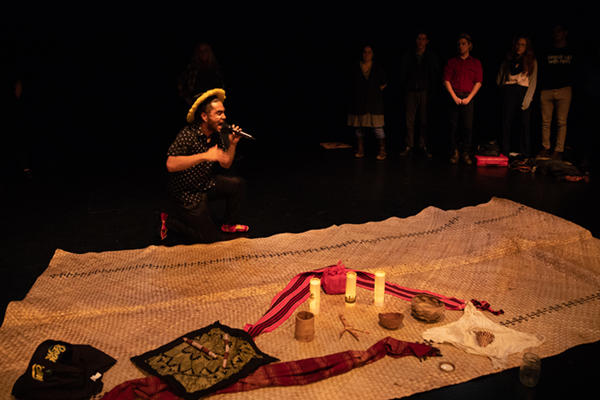
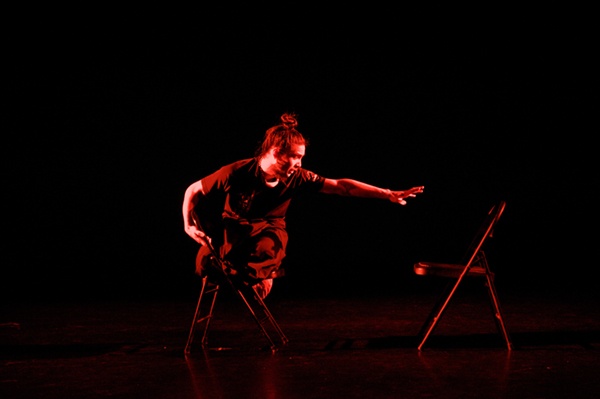
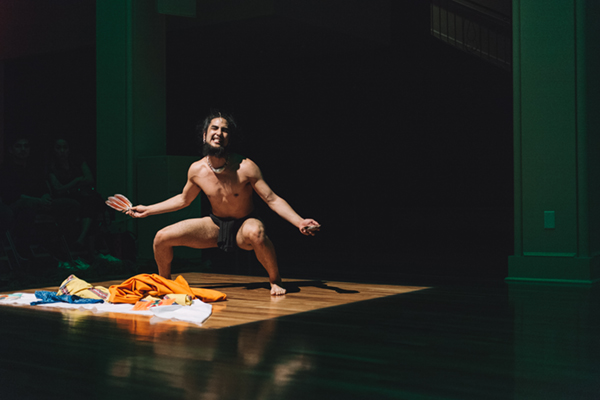
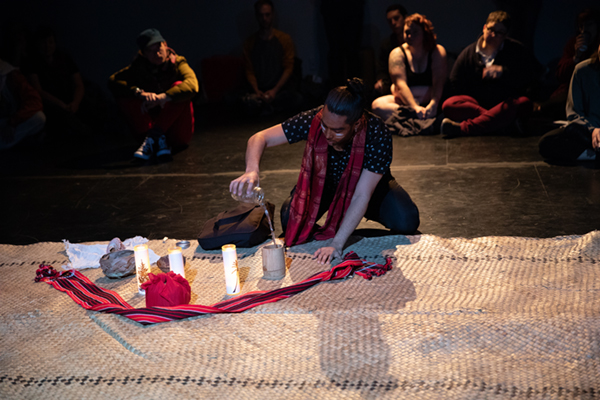
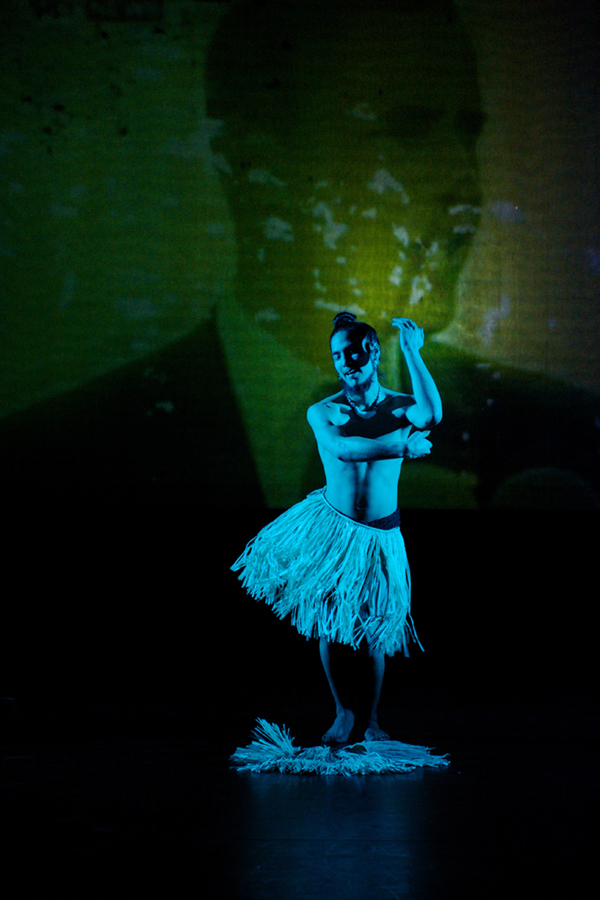
2 Responses to “Indigeneity and Identity”
That’s so great, Jimmy! Thanks so much for sharing!
This inspires me on so many levels and im glad i took the time to read all of it. It Taught me as i expedite my own Projects. There’s strong Lenape Clan history where i am, my Pop’s Bloodline. I actually FEEL a strong connection to the Ritual, Drumming and History and im often “Visioneering” myself Creating from this.
Comments are closed.